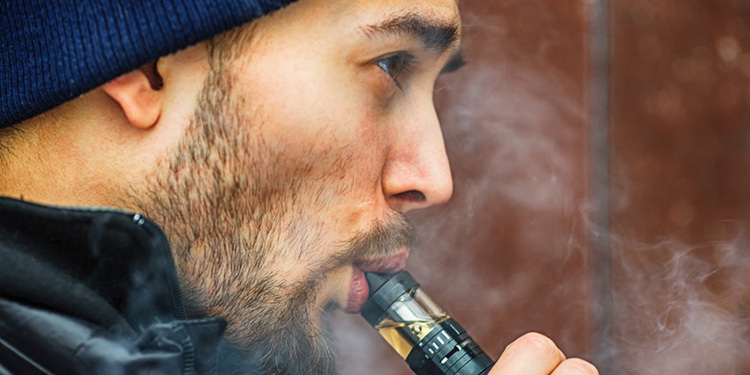
Imagine you have been a smoker for decades.
You’ve tried to quit smoking many times. You tried with nicotine patches for weeks, despite that annoying rash on your arm. You put up with Champix, despite the weird dreams it gave you. You tried nicotine gum, despite the unpleasant, burning sensation in your mouth. But in a moment of weakness – and it only takes one in the midst of many moments of strength – your old friend, the cigarette, lures you back in.
But then one day you try vaping. The hand to mouth action, the sensation of breathing in vapour, the sudden hit on the back of your throat, the vapour dancing and swirling across the room – it may not be smoking, but it’s so damn close it works for you.
Then you go to work. Suddenly, you realise you aren’t allowed to vape inside. In your break you head to the smoking shelter in the cold, damp grey outdoors. A colleague is huddled next to you, smoking. And the lure of your old friend, the cigarette, returns.

It’s a situation vapers across the UK encounter every day. But exactly how many? And of those who can’t vape at work, how many will return to smoking?
I wanted to find out. But with almost zero research into vaping at work, there was little evidence available. So we turned to our newsletter subscribers. Over 1900 of them from across the UK were kind enough to provide answers to a detailed survey, providing a unique window into vaping in the UK workplace.
Vape bans in the workplace
Public Health England (or the UK Health Security Agency as we should now call it) offers clear advice about vaping at work. Vaping is not included under no-smoking laws, there is no evidence of harm from passive vapour and employers should, at the very least, provide an area for vapers separate from designated smoking areas.
Yet only one in four vapers is allowed to vape in the workplace (excluding designated smoking areas). And of those who are allowed to vape, many work in outdoor jobs like construction, where smoking is more likely to be allowed.

Does all this matter? Yes. Almost 1 in 5 respondents said that being forced to use designated smoking areas to vape could mean they would start smoking again. (The figure was slightly higher for men, at 19.5%, than for women, at 17%.)
This situation can be exacerbated by how some vapers are treated at work. Almost 1 in 5 of our respondents said they had received negative reactions because of vaping, 224 felt they had been discriminated against while 44 said they had been bullied. 13 had even been fired for vaping at work. None of this is likely to help someone during the difficult process of quitting smoking!
It’s not all bad news, though. Around half our respondents have introduced a colleague to vaping at work. Given that almost all vapers are current or former smokers, this makes them potentially one of the biggest allies to UK smoke-free goals.
Vape restrictions can harm smoking cessation
England has set ambitious targets to be Smoke Free by 2030, with vaping seen key to achieving this goal. In fact, post Brexit, the UK government hopes to be able to adjust vaping regulations to encourage more smokers to switch.
(Wales also wants to be smoke-free, but has chosen to ignore the most popular and effective way of quitting smoking.)
However, existing research shows that vape restrictions and bans can hamper smoking cessation and even increase rates. For example, one study found that indoor vaping restrictions increased smoking rates by 2%, while another study found that adding vaping restrictions to smoking bans undermined the effectiveness of those bans. Our Vaping in the Workplace Study adds weight to this existing research.

To achieve both a smoke-free UK and a healthier, smoke-free workplace, the country needs more understanding employers.
What to do to if you’re a vaper
Having the right information can help you to create change in the workplace.
The most helpful guidance to show your employer or HR department is that provided by the UK government: Use of e-cigarettes in public places and workplaces. This provides clear advice for employers – including the recommendation that vapers should not be forced to use designated smoking areas:
…vapers should not be required to use the same space as smokers, as this could undermine their ability to quit smoking and stay smokefree, particularly among those most heavily addicted.
Additional resources on the efficacy and relative safety of vaping can be found on websites such as the Royal College of Physicians, Lung Cancer Research, the NHS and many other respected organisations.
It’s also worth reassuring employers that not all devices are cloud machines, and suggesting a code of etiquette. This can include using discreet, lower-powered starter kits at work, and blowing vapour down instead of up or around the room.
Bear in mind that some employers may be loath to allow vaping at a desk or in an office. In that case, a reasonable compromise is to have a dedicated vaping area separate from the smoking area.
You may also find the full results of our Vaping in the Workplace survey useful, as it demonstrates additional benefits to employers in terms of retention, morale and the willingness of workers to return to the workplace post pandemic.
Good luck!
